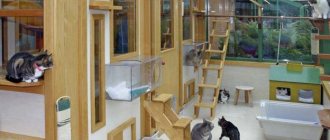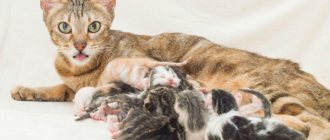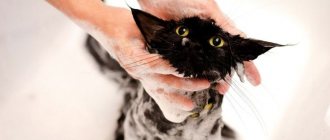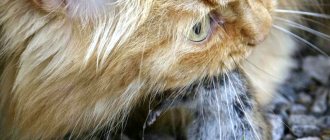How to combine your love for cats with making a profit? You can start breeding them. In order for cat breeding to become a profitable activity, you need to take into account a lot of nuances: calculate investments in the business and the financial return from it, decide on the breed, buy pets, select and equip premises, advertise your services, determine the price of live goods, resolve legal issues.
Business plan for breeding purebred cats
Breeding cats as a business, although pleasant, is not the easiest activity. To start breeding these animals, you need to calculate all the risks that may arise during the work process. Drawing up a business plan, the purpose of which is to calculate investments and approximate profits, will help to minimize them. It is also important to do your research on which breeds are the most profitable.
Finance: how much do you need to invest and how much do you plan to receive?
A business plan allows you to calculate only approximate costs and profits. If investments at the initial stage can be calculated as accurately as possible, then income can be calculated very approximately. How much money it will take to become a breeder of purebred kittens depends on many factors. This is influenced by the region, the planned number of pets, the value of the breed, whether the nursery will be built independently or with outside labor, etc.
Information on the approximate costs of creating a nursery with 10 kittens:
| Expense item | Costs, thousand rubles | ||
| Menstrual | Annual | ||
| One-time | Construction of an enclosure for pets | 150 | |
| Purchasing animals | 400 | ||
| Purchase of inventory | 100 | ||
| Expenses for veterinarian services, registration | 50 | ||
| Permanent | Keeping cats (food, care) | 50 | 600 |
| Nursery maintenance (water supply, electricity/gas, heating) | 80 | ||
| Other (advertising, matings, participation in exhibitions, club membership) | 150 | ||
Based on the figures given in the table, breeding cats at the initial stage will require about 1.5 million rubles. Each of the 8 cats kept in the nursery (the remaining 2 are males) will give birth to at least 4 kittens per year. 32 – number of pets intended for sale per year. The amount of proceeds from their sale will be 1.28 million rubles. (32x40 thousand rubles).
Calculation of business profitability:
- (Income – expenses) x 6% = (1,280,000 – 880,000) x 6% = 24,000 rubles. This is the determination of the amount of taxes under the simplified taxation system (STS).
- Income – expenses – amount of taxes = 1,280,000 – 880,000 – 24,000 = 376,000 rubles. This is the profit for the year.
The most profitable breeds
Having decided to start breeding purebred cats, you need to study which breeds are popular in a given area. You should not focus only on this factor, because, most likely, among the buyers there will be not only local lovers of these animals, but also residents of other regions. Having no experience in this field, it is recommended to start with breeding unpretentious breeds. You need to choose only from those that bring the most profit. These include:
Disadvantages of the "cat" business
It should be noted that the idea of breeding cats also has negative sides. In this case, a lot depends on the desire of the entrepreneur himself, and how much he loves animals. Some cat breeds have a very capricious and whimsical character, which creates many difficulties in everyday life.
The main disadvantage of the cat breeding business is the significant time investment. In addition, the breeder will need a large supply of strength and patience.
High competition
Kittens require constant care, which includes not only regular feeding, but also bathing, litter box training, and proper upbringing. The possibility of diseases that will require costs for medications and specialist services should not be excluded.
Another disadvantage of the “cat” business is high competition. Breeding purebred animals for further sale is not a new type of business, but it has gained significant popularity due to the appearance of breeds that were previously extremely rare. On the other hand, competition is fully compensated by the high demand for pedigree animals, and therefore does not cause significant difficulties.
In general, cat breeding as a business has certain disadvantages, but if you have the necessary qualities and knowledge, the difficulties that arise can be overcome without any damage.
Selection and equipment of premises
The room for keeping animals should be spacious, warm and bright. When living in a private house, it is advisable to allocate a separate large room for pets.
If possible, males, females and new four-legged mothers with babies should be housed separately. So that your children can frolic in the fresh air, it is better to make an open enclosure for them - an area fenced with a net, equipped with a canopy, opaque partitions and equipped with ventilation, heating and lighting.
The room where pets are kept must have:
- cells;
- carrying;
- stable and convenient bowls for food and water;
- trays (it is better to choose models with a grid and without filler, as they are easier to clean);
- cat litter (it is recommended to use granular or wood litter - they absorb odor better, which is especially important when keeping animals in large numbers);
- toys;
- high-quality ready-made food or self-prepared food from good products;
- care products (pet shampoos, combs for combing (they must be selected taking into account the characteristics of the coat of a particular breed), trimmers, toothbrushes and pastes, solutions for cleaning eyes and ears, nail clippers);
- houses where pets could retire;
- scratching posts;
- rugs
Where to begin
The first thing you must do is make a plan. No successful business can happen without careful planning. You must take into account everything: the cost of purchasing animals, their maintenance, veterinarian, exhibition. When assessing where to start breeding cats, you need to understand that sometimes unforeseen situations occur that require additional investment.
The next step is preparing the premises. It is more convenient to maintain a nursery with several animals in a private home. In this case, cats will have to be allocated a separate room, and perhaps more than one, depending on how many animals are supposed to be kept. Careful planning of matings and selection of pairs will require you to separately house males, females and recently given birth females with litters.
In addition, you will need an area for walking and playing. An excellent solution is to make an outdoor enclosure. For these purposes, a strong mesh and a sun canopy are usually used. Of course, you can organize the breeding of cats at home, that is, in an apartment, but in this case you can keep no more than one pair, since the space is quite limited.
Cage for breeding cats
Now you must decide how many animals to purchase. You won’t get much profit from one pair, since the cat needs a rest from giving birth, but during this period it still feeds and requires care. This means we calculate how many females we need so that they consistently produce kittens throughout the year. In this case, you will have to take into account how popular the chosen breed is in your city and whether you will be able to sell the resulting number of cubs. If they are delayed, you will incur additional maintenance costs.
Therefore, your business plan should include:
- expenses for preliminary preparation of the premises;
- expenses for the purchase of breeding animals;
- maintenance costs;
- additional expenses: veterinarian, diet food for indigestion and some diseases;
- costs of feeding kittens;
- calculation of animal maintenance not only during pregnancy, but also during the rest period.
You are now ready to purchase breeding pairs. There are several options here.
- We purchase young kittens and raise them until puberty.
- We purchase grown-up cats and female cats from trusted nurseries.
- We only purchase cats and then pay for breeding.
Each option has pros and cons. When buying kittens, you still don’t know what will grow out of them, so you need to choose a nursery as carefully as possible, having studied the pedigrees of the parents. When buying older kittens, you get cats that are almost ready for breeding, but, again, you must be sure that the animals sold to you are no more than a year old. If you choose the option of paying for matings, you must be prepared for expenses: the more elite the male, the more expensive the mating will cost. For some breeds it can reach 20-50 thousand rubles.
Purchasing breeding animals: where, how many, how to choose?
You should buy purebred kittens only from reliable nurseries with a proven reputation. Qualities of an ideal four-legged candidate for purchase:
- age at least 3 months;
- full compliance with breed standards;
- absence of congenital defects and external defects;
- the parents of the baby have good health and a balanced psyche;
- belonging to the breeding or show class.
Nursery equipment
Before you make money on cats, you will have to invest a lot in the business. In addition to building a room where you will keep animals, you will have to spend a certain amount on purchasing the most necessary equipment. You need to make purchases in large brand stores offering high quality products. The minimum list for 10 pairs of animals will be as follows:
- exhibition carriers (4) – 12,000;
- mini-houses (20) – 34,000;
- aviary cages (4) – 4,000;
- rugs (20) – 18,000;
- combs, nail clippers, trimmers (8) – 4,000;
- toilets (20) – 2,000;
- feed (15 kg) – 5,000;
- bowls (50) – 25,000;
- toys and accessories – 5,000;
- toilet filler – 1,000;
- shampoos, brushes, washing containers – 2,000;
- playground (2) – 16,000.
That is, the cost of purchasing equipment will cost around 128,000 rubles. At the same time, it is important not to skimp on the quality of equipment and food, because the level of demand for them will depend on the health and appearance of your pets.
Maintenance of purebred cats (care, feeding, etc.)
What you need to avoid when breeding these animals is trying to save money on their maintenance. Cheap food and poor quality care will negatively affect the appearance of pets, and this, in turn, will affect their cost. Cats should be fed high-quality ready-made food (the preferred option) or food prepared independently from high-quality products. It is recommended to discuss this point with your veterinarian. If necessary, the veterinarian will prescribe vitamin and mineral complexes.
When choosing a feeding method, it is necessary to take into account the characteristics of the breed. You also need to monitor the timeliness of replacement and the quality of drinking water. Trays, bowls, cages, carriers and beds should always be clean. To ensure that the inhabitants of the nursery are well-groomed, they should be regularly bathed, combed, their nails trimmed, and their ears, eyes and teeth cleaned. It is recommended to conduct preventive veterinary examinations quarterly. Regular deworming and vaccination are required.
Choosing a cat breed
The first important step is to decide what specific material you will work with. Which cat breed should I choose for breeding?
★ Investment assessment for a business plan in Excel. Calculation of NPV, IRR, DPP, PI in 5 minutes
You can go 2 ways:
1) carefully study photographs of cats of various breeds and select a few that you liked visually. Because if you don’t like the way your pet looks, then it’s difficult to expect a correct and proper attitude towards it. Next, you need to read the characteristics of the breeds you have chosen. It happens that a person himself is very calm, melancholic or phlegmatic in temperament, and it is difficult to imagine how he will cope with cats of “reactive” breeds. And the last step: from the list reduced to 2-3 breeds, you will need to select a breed whose representatives you can financially afford to purchase.
2) initially, despite all the “buts” and enemies out of spite, choose a breed based on the maximum “exhaust” after selling the litter.
There are a huge variety of cat breeds at the moment. The vast majority of them are “legalized” by various cat federations and allow you to breed them completely calmly (with the right approach). There are some newly bred breeds, or controversial species, which are recognized by some and not recognized by others, but we will not remember them now.
So, an approximate list of cat breeds that are in high consumer demand:
1) Maine Coons (people love these cats for their huge size. An adult Maine Coon looks like a small lynx and always impresses those who look at it);
2) oriental cats (graceful cats with a dog's face and ears in the form of bat wings);
3) Scottish folds (plush fat dogs with curled ears);
4) sphinxes (several types of “hairless” cats);
5) British shorthairs (just plush fatties);
6) Russian Blues (cats with only one color - blue, green eyes and an aristocratic character);
7) Persian (cats with flat faces and increased shaggy hair);
 Kurilian bobtails (cats with short tails, similar to lynxes);
Kurilian bobtails (cats with short tails, similar to lynxes);
9) Abyssinian (graceful cats with bright colors and crazy temperament);
10) Siberian (originally Russian furry cats);
11) Bengal (cats similar in color and posture to leopards).
Of course, you must take into account the purchasing power of the population of your place of residence and the popularity of the breed in your region.
The next step is educational program. Don't go to bookstores for cat books. They sell either reprints of old books in beautiful covers, or uninformative but expensive cat photo albums with beautiful photographs. Publishers are people too, and they want to make money. Therefore, go online, register on “cat lovers” forums, go to the section on your breed and start reading and reading. The forums contain the most valuable and lively information. You will gain more knowledge there than anywhere else. Before rushing with your questions into the seething communication of breeders (people involved in breeding cats) and not looking like a black sheep against their background, you need to learn the breed standards so as not to screw up in the first round. And don’t even think about asking questions like “How much do kittens of my breed cost?” and “Where is the best place to sell kittens?” You don't want to be thrown into the abyss, do you? And in this case you will simply be torn apart. After all, not a single breeder admits that he breeds cats for money either. Only in the name of high ideals and improvement of the breed!
To approach practice, you need to learn the theory. That is, in order for you to become a real breeder, so that later you will be recognized by your own people, you must undergo training in felinologist courses, which last on average 3 months, with mandatory exams and obtaining a diploma for the right to engage in felinological activities. Without this diploma, you will not be able to register the nursery where you intend to breed. And without a cattery, you will not have serious applications for serious work, and “your” kittens will not be able to be registered. And unregistered kittens fall sharply in price, otherwise they wouldn’t have to be adopted for free by friends and acquaintances.
| Business valuation | Financial analysis according to IFRS | Financial analysis according to RAS |
| Calculation of NPV, IRR in Excel | Valuation of stocks and bonds |
Matings, pregnancy, birth, care of kittens before their sale
Usually, upon reaching 7–8 months of age, pets are already capable of procreation. The most reliable evidence of their body’s readiness to bear and give birth to kittens is the first heat. However, it is recommended to breed cats for the first time no earlier than 1.5 years. You need to look for a partner for mating (if there was no goal of purchasing a cat pair) in advance in special clubs, at exhibitions or through private advertisements.
Only absolutely healthy, vaccinated and dewormed animals are allowed to participate in this procedure. Mating should take place in a calm environment. If problems arise, you need to be able to help the cat. The duration of a meeting between a four-legged gentleman and a lady is on average 3–5 days.
Pregnancy lasts about 6–8 weeks. It is recommended to isolate a pregnant cat from other inhabitants of the cattery. The expectant mother requires special care and nutrition. If problems arise during the process of bearing cubs (prolonged lack of appetite, uncontrollable vomiting, lethargy, etc.), you should immediately call a veterinarian. The desire to create a “nest”, licking of the genitals, anxiety, swelling of the mammary glands are harbingers of childbirth.
Usually cats give birth on their own, but you need to be able to help them if necessary. New four-legged mothers, who need to be isolated from other animals, take care of the babies and teach them independence. If for some reason she cannot feed the cubs, they are transferred to artificial feeding with ready-made formulas for feeding kittens, dry formulas for children, or self-prepared mash. This should be done every 2 hours. 4 weeks of age is the optimal time for the first feeding.
The kitten is ready for sale after it reaches 3 months. Until this moment, he must be vaccinated, pre-treated against worms, activated or registered depending on which system the club belongs to, and metrics done.
Buying pets
You may be interested in: Child development and business development: how to combine
Having decided on a breed for a cat business, you need to study all its features. You should know everything about the characteristics of this breed, proper care and nutrition. Only after this does it make sense to buy an animal from a good breeder. It’s good if you have a specialist with you who can help you make your choice.
Kittens purchased for breeding must have a good pedigree, all vaccinations and the necessary documents.
Participation in various exhibitions
Participation in cat shows is an obligatory part of the job. This can be done up to 5 times a year. Participation in such events (it is paid) will allow you to establish cooperation, acquire the necessary contacts and exchange experiences with other breeders. In addition, this is a chance to receive certificates and medals for meeting the breed standard and, on this basis, sell kittens at a better price. Animals under 3 months of age cannot take part in exhibitions.
How to register a business
From 2022, any income is subject to taxation. Cat breeders are no exception.
If your annual income does not exceed ₽2.4 million and there are no employees, you can register as a self-employed citizen and pay the state at a preferential rate of 4-6% of your earnings. In other cases, you will have to register as an individual entrepreneur, which requires:
- statement;
- copy of Russian passport;
- document confirming payment of state duty.
OKVED number 01.49.5 “Breeding of domestic animals”.
Legal side of the matter: registration, joining the club, taxation
To start this business, you need to register with a club that holds exhibitions and deals with paperwork for animals and nurseries. To obtain breeder status, you need to submit an application to this organization, and it, in turn, will send it to the international federation, where it will be checked for uniqueness and a decision will be made to issue a certificate for opening a nursery. This procedure takes from several days to several weeks.
You should also become a member of the club by paying an annual membership fee. Through it you can issue certificates for adult pets, diplomas, pedigrees, and on its website you can post advertisements about finding a partner for breeding and selling kittens.
According to recent changes in legislation, only legal entities and individual entrepreneurs can breed animals and trade them. This means that every breeder who sells cats is required to pay taxes even if they have one litter per year, otherwise their activities are considered illegal. The most profitable is the simplified tax system with a 6 percent tax rate.
Brief information about income and expenses
It is important to understand that love alone is not enough to breed cats. This business is no different from opening your own store, so you will also have to invest money in it before making a profit.
What to invest in
At the initial stage you will have to invest in:
- construction of a special enclosure;
- business registration and collection of accompanying documents;
- purchasing purebred parents;
- various devices and consumables (trays, fillers, food, bowls, carriers, toys, scratching posts, beds, hair care products, veterinary kit).
You will have to spend at least 120 thousand rubles on one breeding pair. If the breed is rare, this amount may be higher, and if there is only one cat without a cat, it may be lower. In the second case, the expense item will be increased due to the need to periodically “rent” someone else’s animal.
Experienced breeders recommend not limiting yourself to one pair of parents and adopting several at once. This will increase the initial costs, but will shorten the payback period and help you achieve profit faster. Taking into account all the listed investments and the presence of more than two pairs of mustachioed producers, the starting capital should be approximately 1.1-1.6 million rubles.
IMPORTANT!
The figures given are approximate. They will depend on your initial conditions.
How profitable is this business?
On average, one pet gives birth to 3-4 cubs. Depending on the breed, they can be sold for about 50 thousand rubles. Provided there are 10 animals (2 males and 8 females), the amount of revenue in the first year will be 1.2-1.6 million rubles.
To calculate profit from this amount, you need to subtract the initial investment, additional expenses for the year and the amount of taxes. In a good situation, the business will fully or almost completely pay for itself within 1 year, and the first profit (not zero or negative) will appear after the sale of the second or third litter.
NOTE!
Earnings in this business are not regular. Sometimes only 1 kitten is born in a litter.
If you work from home with just one cat or a couple of breeders, you shouldn’t count on an acceptable profit. This option is suitable for those who want to breed animals solely for the soul and are not chasing big money.
The mating itself
If the advertisement has completed its task and you have received calls from people who want to breed their purebred pets with yours, then if you have a cat, you need to take it to the client, since the males “at home” feel more confident. And if you have a cat, then get ready to host “girls.” That is why your enclosure must have a mating room. You can even make several of them, but they must be separated from each other by a corridor and soundproof walls. Alternatively, if you breed cats at home, you need to allocate an empty room. Mating lasts 3-4 days, sometimes 6-8 days. During this period, couples should not be disturbed. Carefully change their water and litter, put food on them and quietly leave without disturbing their peace, just to pet them. If the mating was successful, within 2.5 months you will have an increase in size. These kittens can be sold and paperwork done for them two months after birth. Use all possible sales channels - bulletin boards, recommendations to friends, nursery website.
Reproduction of cats, where to find a cat, sexual behavior
Reproduction of cats, advice for cat lovers.
Reproduction of cats - If you are planning offspring, then it is useful for you to know that female cats reach sexual maturity at 7-12 months, and males at 10-14 months. For most breeds, having more than one litter per year is not desirable. The exception is Siamese cats; they can bear offspring without harm to their health every 7-8 months.
Reproduction of cats. How to find a worthy stud cat.
If you are the owner of a purebred cat, but nevertheless are new to the business of breeding cats, then you need to entrust this matter to a specialist. This could be a veterinary clinic or a breeder of purebred cats. What you need to know.
a conscientious breeder has a specially designated room for a male cat;
the room should be warm, cozy, private and clean;
all animals have appropriate pet health certificates (be prepared that you will also be asked to provide such a certificate);
to use the manufacturer, you will need to pay its owner. If the first coating is unsuccessful, then the cat is brought for mating a second time for free.
Reproduction of cats. When can a cat become pregnant?
A cat's reproductive cycles are seasonal, most often beginning in January, reaching a peak in March-April, June and September. October to December are usually absent, although there are exceptions. Sexual cycles are completely dependent on the length of daylight hours, so in cats that do not leave the house, sexual cycles appear all year round under the influence of artificial light. In each phase of sexual activity, there are 2-3 sexual cycles lasting two weeks. Estrus (hunting) lasts 2-4 days.
Reproduction of cats. Sexual intercourse.
Ejaculation occurs immediately after insertion of the penis into the vagina and is often accompanied by a short and shrill meow from the cat. Having separated from the female, the cat moves away and watches the cat. At this time, the female rolls on the floor, stretches out, spreading her paws. Voluptuously releases its claws. After 5-10 minutes, the mating process is repeated. Mating can occur several times a day.
Reproduction of cats. Courtship.
Even if a cat is completely ready to mate, she often resorts to a certain ritual, driving the cat away and rejecting his advances. She hisses and extends her claws. The cat perceives such aggression from the female passively: he does not fight back, but, dodging the blow, again resumes attempts at courtship. With a plaintive meow, the cat asks for “the lady” and expects a more acceptable answer from her. This game lasts until the cat softens to the inviting meows and turns its back to its “suitor.” This is the signal to start mating.
Homecoming.
When you take your cat home, she may still be in heat, so don't let her out of the house. If after some time the cat again demands a gentleman, this means that fertilization has not occurred and the cat will again have to be taken to the breeder.
Health to you and your pets.
Myyyyyyyyyyyyyyyyy love cats.











